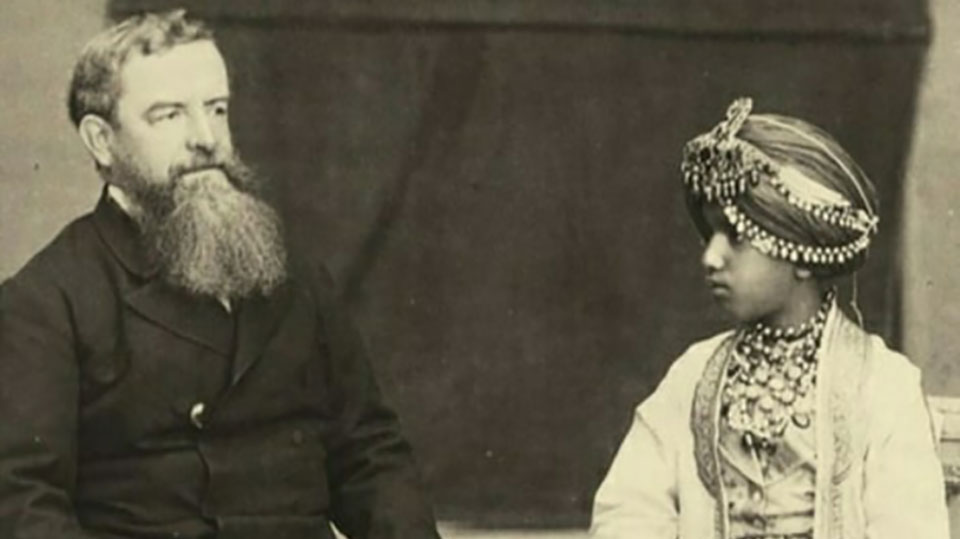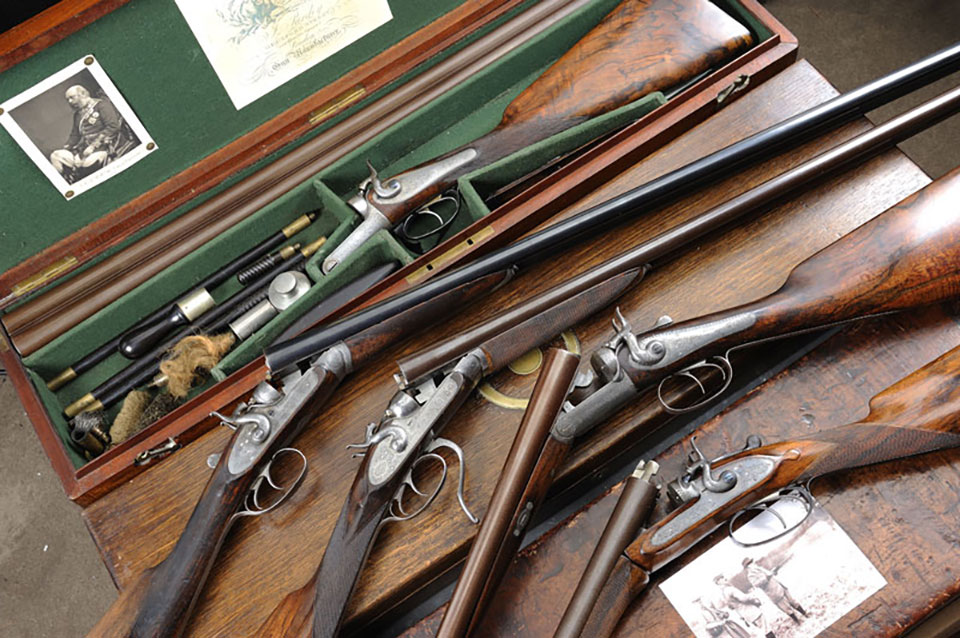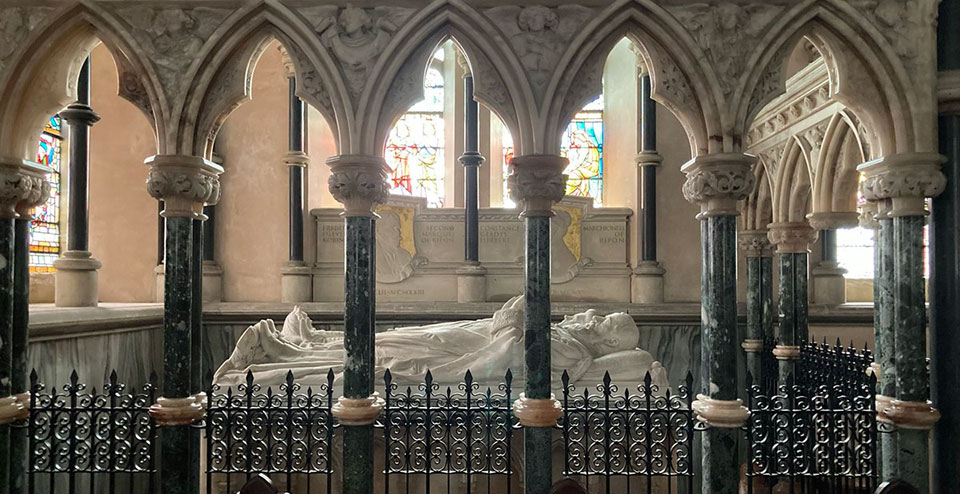The Marquises of Ripon: father and son, represent two sides of Victorian and Edwardian high society.
The 1st Marquis (George Robinson) was born in 10 Downing Street and spent his life in politics, serving in every Liberal cabinet from 1861 until the year before his death in 1909. He was elevated to Marquis for his success as chairman of the joint committee that drew up the Treaty of Washington with the United States over damages caused by British-built Confederate raiders during the US Civil War.
By contrast, the 2nd Marquis (Oliver Robinson) had only a brief career in politics, serving as MP for Ripon between 1874 and 1880 and in the House of Lords after his father’s death. He had a much greater involvement at court, as a friend of both the Prince and Princess of Wales, serving as the latter’s Treasurer once she had become Queen Alexandra in 1901. However, it was as a game shot he is principally remembered, using trios of Purdey hammer guns to legendary effect during a shooting career that spanned nearly sixty years.
While Rupert Godfrey’s biography, Olly, has done much to provide a fuller appreciation of the 2nd Marquis’s life, his Purdey guns remain the subject of misinformation and lore. This is at least partly due to confusion over which belonged to which Marquis, as his father was also a game shot and Purdey client. Although Richard Beaumont wrote at least one article on the subject, his notes suggest that he had grossly underestimated how many guns each man had, almost entirely failing to account for the 1st Marquis.
Various guns have come for sale at auction over the last thirty years, and due to an apparent misunderstanding of the dates and titles of both men not all of which have been attributed correctly. The following information is based upon the accounts Purdey holds for both men, and has been compiled with the assistance of Mr. Godfrey.
In line with his work, both men are referred to by the names used by their family; the 1st Marquis is referred to as George, and his son as Olly. It is necessary to start with George’s accounts, to understand both his gun ownership and the support he provided Olly in his early years, before he achieved his majority at the age of twenty-one.
no direct records of George’s shooting career survive
Unlike his son, no direct records of George’s shooting career survive, and what is known is drawn from his son’s game books and references in correspondence. Although it is known that George and Olly both had pairs of guns from Thomas Horsley of York in 1866, these were definitely not George’s first guns. His first purchase at Purdey was made in July 1863, when he purchased Nos. 6454/5, a pair of 12-bore pinfire hammer guns with ‘guard levers’, for £120.
Despite his purchase of the Horsley pair three years later, these guns still remained in serious use, as evidenced by the need for new barrels on the No. 1 in July 1867, and taking bruises out of one set of barrels in 1868. They were fully refurbished in April 1870, after which they make no further appearances in the accounts, suggesting that they may have been gifted away having been replaced.
Their replacements, a trio of toplever centrefire hammer guns, had been purchased in July 1868 for £189. These were Nos. 7746/7/8, which have often been associated with Olly, with the No. 1 having been displayed as such at Audley House. However, there is no evidence that this trio were ever used by him, as they only ever appear in George’s accounts. This was the first of three trios he owned, and they saw a fairly busy life over their twelve years of recorded service. This included needing to rejoint the No. 3 gun after only two seasons use, and tightening the grips on the other two guns at the same time.

When George was appointed Viceroy of India in 1880, it was this trio that he had refurbished and shipped to him in early September that year, in anticipation of his son’s visit two months later.
Both father and son appear to have overlapped the use of their new guns with their old, seemingly using both for a season or two before finally retiring the older group. This can be seen here, with George having purchased his second trios, Nos. 10,544/5/6, in October 1879. These had Whitworth Steel barrels and third grips, costing £203 19s. Although they were used for that season, they then remained unused during his time in India, only reappearing in the records in February 1885. The charges for their servicing only appear occasionally in the records over the next eleven years, but included rejointing all three in 1890 and 1895.
They were last serviced in July 1896, when they appear to have been cleaned and shortened. Again, this may have been preparatory to gifting them, as George’s stock dimensions had varied only 1/16in. over the course of his life, and in November 1895 he had purchased his last trio, Nos. 14,979/80 & 15,379.

Despite being nearly sixty when he took delivery of this last set, George had made a small concession to modernity by the inclusion of ejectors. They appear to have originally been intended as a pair, with Olly having the next two serial numbers for his own pair of hammer ejectors. The difference in serial numbers suggests that George decided to expand the pair to a trio, and that No. 15,379 was simply the next available number. This is also borne out by the guns only being invoiced in November, whereas Olly’s pair were loaned in July 1894, and formally invoiced exactly a year later.
Interestingly, George’s trio cost £268 6s 6d, or about £89 per gun – roughly in line with the price of a hammerless ejector of the period. By this time his servicing had become much more sporadic. Purdey didn’t see the guns between 1897 and 1902, when all three guns had to be tightened and the No. 2 restocked. They were serviced for the last time in August 1908, for what would turn out to be George’s last season, as he died the following July at the age of eighty-one.
This last trio is the basis of a minor misunderstanding. After George’s death they were separated, being reunited by Paul Roberts before their sale at Christies. At that point they were described as having been made for Olly, but examination of Purdey’s records appears to disprove this attribution. Olly had his own guns, and evidence in both the Purdey archives and elsewhere show just how particular he was about the fit of his guns. As such, while Olly was definitely a dedicated user of Purdey hammer guns for virtually his entire shooting career, it was his father who appears to have more fully embraced the hammer ejector gun.
until Olly achieved his majority, ammunition and expenses for both men passed through George’s accounts.
George’s accounts also include information about several other areas of Olly’s early years. Up until Olly achieved his majority at twenty-one, in 1873, all ammunition and expenses for both men passed through George’s accounts. As such, we have to look there for items relating to Olly’s early years. Even in the pinfire days, George’s ammunition purchases were sizable, with 9,500 taken during the 1864 season. However, this figure never appears to have been exceeded, with the number of cartridges purchased after his son attained his majority seeming only suitable for George’s needs.
Olly’s first year shooting at the live pigeon clubs in London also appears to have been recorded in George’s accounts, covering June/July 1872 and April to July 1873. In 1872 Olly went shooting, mostly at the Hurlingham club, on nine occasions. In 1873, however, a Purdey representative met him at either Hurlingham or the Gun Club on fifty-four occasions. From the second half of May until the last entry on 5 July, he appears to have effectively been shooting live pigeon six days a week. This marks the start of a pattern that appears to broadly continue for the next decade.
As can be seen, the 1st Marquis of Ripon, although not shooting the same volume of game as his son, was a capable and committed game shot in his own right. His political career, and spending some of the 1870s at the monastery of San Damiano following his conversion to Catholicism, explains some of the gaps noted above, but he certainly provided support to his son’s early shooting career. In fact, in George’s accounts in the 1870s the accountants would pencil ‘Ripon’ against the few entries relating to George, with the rest apparently down to his son!
Having separated out George’s guns, it is now possible to discuss Olly’s gun ownership and usage. We shall do so in two articles, beginning next month in the Vintage Gun Journal.

Dr. Nicholas Harlow is Gunroom Manager at James Purdey & Sons in London.
NOTES:
The author would like to thank Rupert Godfrey for his kind assistance with the preparation of this article.
Published by Vintage Guns Ltd on (modified )




